 |
 |
|
|
| Home | Events | Donations | GuestBook | Email Login |
|
|
 Celebrating Thirty Years of Punk Rock August 6 - 17, 2006 |
| << BACK | Wasted Home Page - 1 - 2 - 3 - 4 - 5 - 6 - 7 - 8 - 9 - 10 - 11 - 12 - 13 - 14 - 15 | NEXT >> |
| The Big Bus Tour of London Continues... |
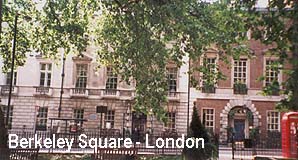 |
Berkeley Square is a town square in the West End of London in the City of Westminster, originally laid out in the mid 18th century by architect William Kent. It is named after the noble Gloucestershire family of the same name whose London home, Berkeley House, had stood nearby until 1733. During his childhood, Winston Churchill lived at No. 48 Berkely Square. The house next door at No.50 Berkeley Square is the most infamous haunted house in London. |
|
When William Hamley first opened a toy shop in London, Westminster Bridge had just opened to traffic (i.e. horses and carts). Even gaslights would not illuminate the city's streets for another half a century. The year was 1760, but William Hamley, a Cornishman from Bodmin, was not put off. |
|
By the end of Queen Victoria's reign, croquet sets, cricket bats and footballs jostled with marionettes, magic lanterns and model sailing boats on the shop's packed shelves. |
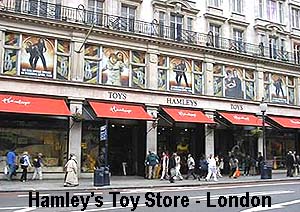 |
| Even being bombed five times in World War II did not stop Hamley's. The staff (wearing tin hats) served at the front door, rushing in to collect the toys, and hand them over at the door. After the War it was business as usual; the Festival of Britain in 1951 brought a Grand Doll's Salon as well as a vast model railway to hypnotize children of any age.
The new Queen Elizabeth II had not forgotten her own childhood companions. Both Prince Charles and Princess Anne received toys from Hamleys and, in 1955, her Majesty honored Walter Lines with his secondRoyal Warrant as a 'Toys and Sports Merchant'. Hamley's became as much a London attraction as Buckingham Palace or The British Museum. Nowhere was the magic of childhood so precisely captured. And as toys changed, so did Hamley's; in 1981 it moved to 188 -196 Regent Street. It is still the biggest toyshop in the world. Over the years Hamley's has developed an international reputation for choice, quality and innovation. The magical flagship store on Regent Street has over 7 floors packed full of toys and games, with live and interactive demonstrations. |
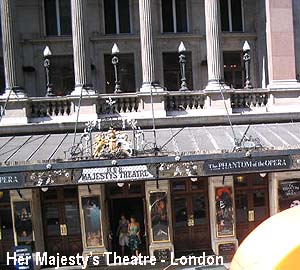 |
The tour also took us through Piccadilly Circus, and soon we were in the Theatre District. One of the most important things to see in the district was Her Majesty's Theatre. |
|
As the tour continued, the bust took us around the National Gallery, Trafalgar Square, and down Whitehall Street past the Admiralty Arch. |
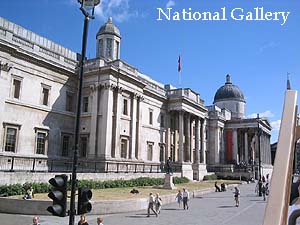 |
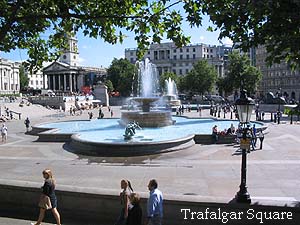 |
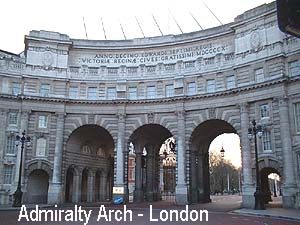 |
|
The building was commissioned by King Edward VII in memory of his mother Queen Victoria, although he did not live to see its completion. A Latin inscription along the top reads: : ANNO : DECIMO : EDWARDI : SEPTIMI : REGIS : Admiralty Arch is a Grade I Listed Building. In the United Kingdom the term 'Listed Building' refers to a building or other structure officially designated as being of special architectural, historical or cultural significance. It is a widely used status, applied to around half a million buildings. A listed building may not be demolished, extended or altered without special permission from the local planning authority. |
|
A short time later, we came to Horse Guards, a large building in the Palladian style between Whitehall and Horse Guards Parade. It is marked by a statue of a mounted Guard. |
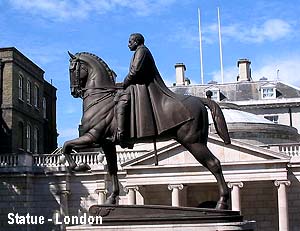 |
|
Tiltyards were a common feature of late medieval castles and palaces. Horse Guards Parade was constructed by Henry VIII as an entertainment venue where tournaments were held.
It was also the scene of the annual celebrations of the birthday of Queen Elizabeth I. |
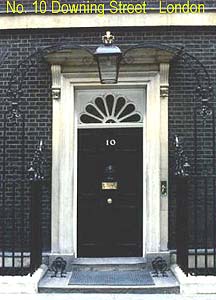 |
The parade ground is open on the west side, where it faces Horse Guards Road and St. James's Park. It is flanked on the north by the Old Admiralty and the Admiralty Citadel, and on the south by the Foreign & Commonwealth Office and the back wall of No.10 Downing Street. Access to this side of Horse Guards Parade is now restricted for security reasons. |
|
The tour continued and soon passed the Big Ben, the Houses of Parliament, Westminster Abbey, and crossed over the Westminster Bridge. It was constructed in 1854-62 from the designs of Thomas Page. It was the second bridge over the River Thames (London Bridge being the first) and was built to replace an older stone bridge. The 353m/810ft long bridge is one of the most elegant of the London bridges and commands a fine view of the Houses of Parliament. On the Westminster side of the bridge stands a huge bronze sculpture of Boadicea (also Boudicca), Queen of the Iceni, one of two British women to be mentioned by the Romans in their writings. She was the wife of King Prasutagus who was given the Client Kingship of the Iceni after the Icenian civil war of 47 AD. Following Prasuttagus' death, around 60 AD, the kingdom was pillaged by the imperial procurator Decianus Catus. |
|
Boadicea took the matter to a higher Roman authority, which resulted in her being publicly flogged and her daughters violated. |
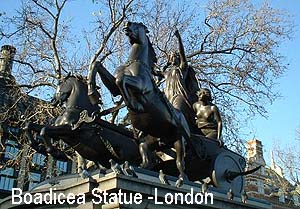 |
| The Florence Nightingale Museum is located at St Thomas' Hospital, which faces the Palace of Westminster. It is open to the public seven days a week. The museum tells the story of the life and work of Florence Nightingale, the founder of modern nursing in the United Kingdom. In 1860, four years after her famous involvement in the Crimean War, Nightingale founded the Nightingale Training School for nurses at St. Thomas' Hospital. Florence Nightingale was born into a rich, well-connected British family at the Villa Colombaia in Florence, Italy. She was named after the city of her birth, as was her older sister Parthenope (the Greek name for the city of Naples). Her parents were William Edward Nightingale and Frances ("Fanny") Nightingale née Smith. Her parents forbade her to practice nursing, and instead insisted that she engage in marriage and a family. Inspired by what she took as a divine calling, experienced first in 1837 at Embley Park and later throughout her life, Nightingale committed herself to nursing. This demonstrated a passion on her part, and also a rebellion against the expected role for a woman of her status, which was to become an obedient wife. In those days, nursing was a career with a poor reputation, filled mostly by poorer women, "hangers-on" who followed the armies. In fact, nurses were equally likely to function as cooks. Nightingale announced her decision to enter nursing in 1845, evoking intense anger and distress from her family, particularly her mother. She cared for poor and indigent people. In December 1844, in response to a pauper's death in a workhouse infirmary in London that became a public scandal, she became the leading advocate for improved medical care in the infirmaries and immediately engaged the support of Charles Villiers, then president of the Poor Law Board. This led to her role in the reform of the Poor Laws, extending beyond the provision of medical care. |
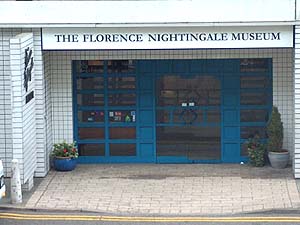 |
In 1846 she visited Kaiserswerth, Germany, and learned more of its pioneering hospital established by Theodor Fliedner and managed by an order of Lutheran deaconesses. She was profoundly impressed by the quality of care and by the commitment and practices of the deaconesses. Nightingale's career in nursing began in earnest in 1851 when she received four months' training in Germany as a deaconess of Kaiserswerth. She undertook the training over strenuous family objections concerning the risks and social implications of such activity, and the Roman Catholic foundations of the hospital. While at Kaiserswerth, she reported having her most important intense and compelling experience of her divine calling. On August 12, 1853, Nightingale took a post of superintendent at the Institute for the Care of Sick Gentlewomen in Upper Harley Street, London, a position she held until October 1854. Her father had given her an annual income of £500 (roughly $50,000 in present terms) that allowed her to live comfortably and to pursue her career. James Joseph Sylvester was her mentor. The museum has a resource center which is open by appointment to students, academics and other researchers, who may utilise the museum's collections, books and documents related to Florence Nightingale. |
|
The tour continued on its way and the guide described all the fascinating sites. I was entralled with Amy's knowledge of the area and I thought it was wonderful to learn so much about the buildings and landmarks of the famous city. |
| The Royal Courts of Justice, commonly called the Law Courts, is a building that houses the Court of Appeal and the High Court of Justice of England and Wales. Courts within the building are open to the public although there may be some restrictions depending upon the nature of the cases being held. The building is a large grey stone edifice in the Victorian Gothic style and was designed by George Edmund Street, a solicitor turned architect, and built in the 1870s. The Royal Courts of Justice was opened by Queen Victoria in December 1882 and became the permanent home of the Supreme Court. It is on The Strand, in the City of Westminster, near the border with the City of London and the London Borough of Camden. It is surrounded by the four Inns of Court. Those who do not have legal representation may receive some assistance within the court building. The Citizens Advice Bureau has a small office in the main entrance hall where lawyers provide free advice. There is usually a queue for this service. (I wish they had something like this in the States…) There is also a Personal Support Unit where litigants can get emotional support and practical information about what happens in court. The main criminal court (Crown Court), housed separately, is the Central Criminal Court, popularly known as the "Old Bailey." (For you movie buffs, that was the first building blown up by the character "V" in the beginning of the film "V for Vendeta.") |
 |
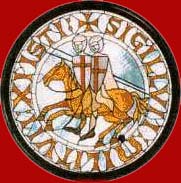 |
The Temple Church is a late 12th century church located between Fleet Street and the River Thames, built for and by the Knights Templar. Popularly known as the Knights Templar or the Order of the Temple, the order were among the most famous of the Christian military orders. The organization existed for about two centuries in the Middle Ages, created in the aftermath of the First Crusade of 1096 to ensure the safety of the large numbers of European pilgrims who flowed toward Jerusalem after its conquest. The Templars were an unusual order in that they were both monks and soldiers, making them in effect some of the earliest "warrior monks" in the Western world. The order's Knights were also famous and easily recognized, with a white surcoat with distinct red cross emblazoned above the heart or on the chest, as seen in many portrayals of crusaders. Members of the Order played a key part in many battles of the Crusades, and the Order's infrastructure innovated many financial techniques that could be considered the foundation of modern banking. After Jerusalem was lost to Saladin in 1187, the Crusades gradually wound down and European support for the Order began to falter. In the early 1300s, King Philip IV of France (also known as "Philip the Fair") was in desperate need of money to continue his war with the English. Already deeply in debt to the Templars, on Friday, October 13, 1307 (a date incorrectly linked to the origin of the Friday the 13th legend), Philip had many French Templars simultaneously arrested, charged with numerous heresies, and tortured until they "confessed." |
|
This action released Philip from his obligation to repay his loans. King Philip also pressured the church to take action against the Templars. When a pope refused, Philip had him kidnapped or executed, until a pope to his liking was named to the position. |
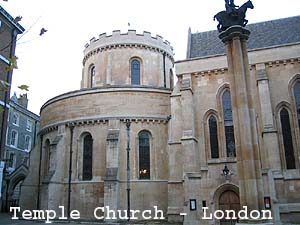 |
|
Two Inns of Court (Inner Temple and Middle Temple) both use the church, which is famous for its effigy tombs. It was heavily damaged during the Second World War but has been largely restored. I snapped off many more photos as the tour made its way through the city. |
Next Installment: Even More of the Big Bus Tour |
| << BACK | Wasted Home Page - 1 - 2 - 3 - 4 - 5 - 6 - 7 - 8 - 9 - 10 - 11 - 12 - 13 - 14 - 15 | NEXT >> |
| Home | Events | Donations | GuestBook | Email Login |
|
|